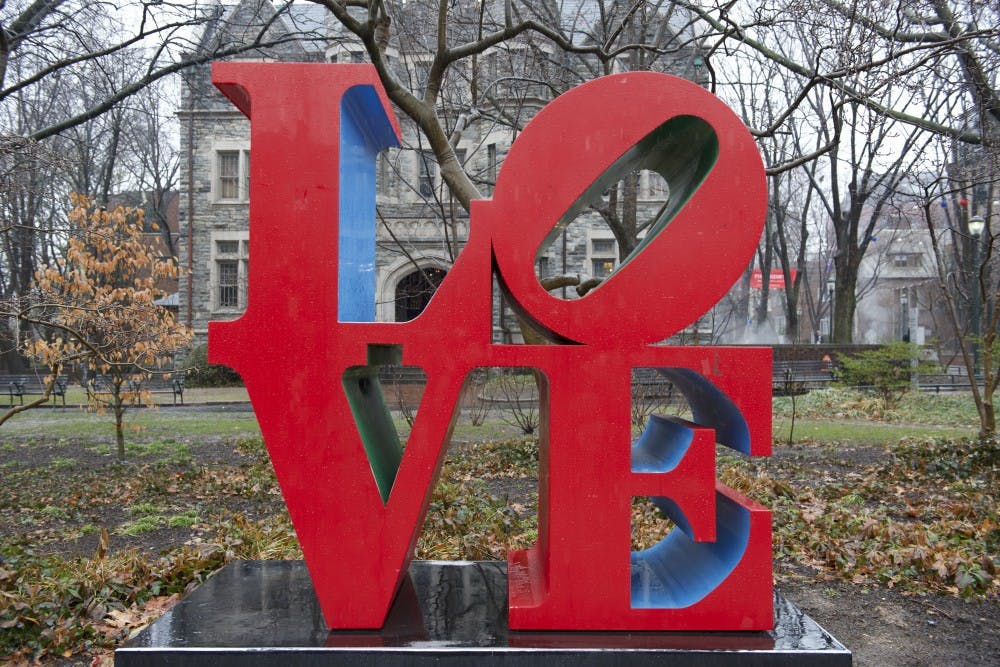Every day we walk past it, barely affording it a glimpse while every tourist flocks to it so as to sneak a peek at the marvel. It’s a prime landmark on campus—the LOVE statue. Right in the center of campus, surrounded by ivy–covered red brick buildings, the LOVE statue has as its backdrop a picturesque scene. Spring or winter, the tree–lined walk is always blanketed in either green or white. But the LOVE statue is so much more than another monument only tourists appreciate.
To be fair, the LOVE statue on campus is not the original. The original started as a pop art image by American artist Robert Indiana, the red letters cast before a background of blue and green. The slanting of the O was designed intentionally as to have the negative spaces forming a V in between the letters, which as Indiana says “makes the letters dynamic.” Before long, the popularity of the piece brought the piece to serve as a print image for the 1964 Museum of Modern Art Christmas card, then becoming a popular US postage stamp in 1973.
It was in 1970 that the print image was brought to life in sculptural form. Fabricated from sheets of COR–TEN steel, the material was bolted together to transform the two–dimensional design into a three–dimensional one. Since 1970, that statue has been on display at the Indianapolis Museum of Art, but countless replicas have been made since.
Particularly of interest to us, however, are the copies in Center City and on campus. The one in Center City debuted during the 1976 bicentennial celebration and has since became one of the most popular sculptures in the city. It was installed on a loan, but when Philadelphia could not pay back the $45,000 sticker price, it had to be returned to Indiana in 1978. In response, F. Eugene Dixon, former owner of the Philadelphia 76ers basketball team, bought the sculpture and donated it to the city the same year.
As to the one on campus, Penn’s LOVE statue was gifted to the school in 1996 from Jeffrey J. and Sivia Loria, an American art dealer and former owner of the Miami Marlins. When it was installed in the triangular patch of green at the 36th Street and Locust Walk, it replaced a sculpture called “We Lost” by Tony Smith that now sits in front of the Singh Center for Nanotechnology.
The symbolism behind the statue is not merely a statement of love. At the time the first of the series was built, "love" was meant to encompass conceptions of free love, the sexual revolution, and anti–war counterculture movements. But the meaning was also a personal one to the artist. Growing up, Indiana attended the Church of Scientology. At the services, he saw a tiny plaque over the reader’s platform with the words “God is love” inscribed on it. In fact, his first artworks bore the same words “God is love” before he later decided to shorten the phrase to just "LOVE." In that, the word “love” also has a spiritual connection.
The statue shows that one does not have to know all the technical terms to talk about art or to be touched by art. The emotions embedded in LOVE are complex, yet accessible and universal. Around the time Indiana began creating LOVE, he was also working on other works earmarked by the words EAT, HUG, and DIE, but the others never caught on the way LOVE did. If anything, it’s a testament to the strength of love.
Indiana had conceived of his statue as a means to “cover the world with love.” For Philly, the City of Brotherly Love, he had envisioned a larger statue that stood 24 feet high with an internal staircase. He says, “that way you could be in LOVE, not just beside it or on it.” Though that project never came to fruition, the very presence of the LOVE statue is a reminder of just how ubiquitous love is. Physically and conceptually.
And yes, while the LOVE statue has certainly garnered its fair share of attention, it cannot encapsulate the real love surrounding us.

